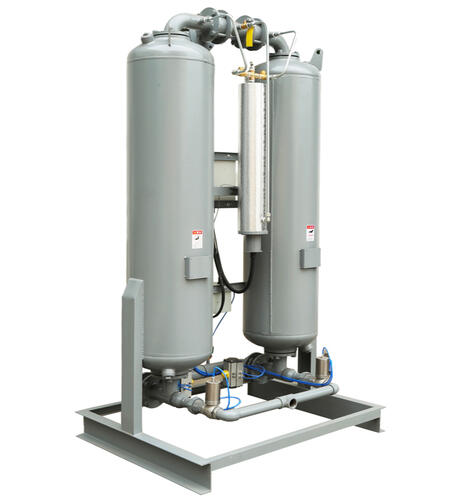Function of Heated Desiccant Air Dryer
Heated desiccant air dryers are an essential component of many industrial and commercial air compressor systems. They are designed to remove moisture and other contaminants from compressed air, which can cause damage to equipment and reduce efficiency. In this article, we will discuss the function, dew point, and applications of heated desiccant air dryers.Function of Heated Desiccant Air Dryers:The function of a heated desiccant air dryer is to remove moisture and other contaminants from compressed air. Compressed air typically contains high levels of moisture, which can cause corrosion, rust, and other damage to equipment. Moisture can also cause freezing in pneumatic tools, valves, and other components, leading to decreased efficiency and increased maintenance costs.To remove moisture from compressed air, a desiccant air dryer uses a process called adsorption. In this process, the dryer forces compressed air through a bed of desiccant material, typically silica gel or activated alumina. The desiccant material adsorbs moisture and other contaminants from the compressed air, leaving it dry and clean.Heated desiccant air dryers take this process a step further by using heat to regenerate the desiccant material. After the desiccant material has adsorbed moisture from the compressed air, it becomes saturated and needs to be regenerated. Heated desiccant dryers use a heater to warm the desiccant material, which releases the moisture and other contaminants that have been adsorbed. This process allows the desiccant material to be reused for future cycles.Dew Point:The dew point is a crucial factor to consider when selecting a heated desiccant air dryer. The dew point is the temperature at which moisture in the air will condense into liquid form. The lower the dew point, the drier the compressed air will be. To achieve the desired dew point, heated desiccant air dryers typically operate at high temperatures, around 200-250 degrees Fahrenheit.The dew point of compressed air depends on several factors, including the temperature and humidity of the compressed air, as well as the pressure at which the air is compressed. Higher pressure can increase the dew point, while lower temperatures and humidity can decrease it. The dew point of compressed air must be carefully controlled to prevent moisture from condensing and causing damage to equipment.Applications of Heated Desiccant Air Dryers:Heated desiccant air dryers are commonly used in a wide range of industrial and commercial applications. Some of the most common applications include:Manufacturing: Heated desiccant air dryers are used in manufacturing facilities to remove moisture and other contaminants from compressed air used in pneumatic tools, conveyor systems, and other equipment.Food and Beverage: Heated desiccant air dryers are essential in the food and beverage industry, where dry air is necessary to prevent contamination of products and equipment.Medical and Pharmaceutical: Heated desiccant air dryers are used in medical and pharmaceutical applications to provide clean, dry air for critical processes and equipment.Automotive: Heated desiccant air dryers are used in automotive manufacturing and repair facilities to remove moisture and contaminants from compressed air used in painting and other processes.Electronics: Heated desiccant air dryers are used in electronics manufacturing to provide clean, dry air for sensitive components and equipment.In conclusion, heated desiccant air dryers are a critical component of many industrial and commercial air compressor systems. They are designed to remove moisture and other contaminants from compressed air, which can cause damage to equipment and reduce efficiency. By using a process called adsorption and heating to regenerate the desiccant material, heated desiccant air dryers provide clean, dry air for a wide range of applications.
